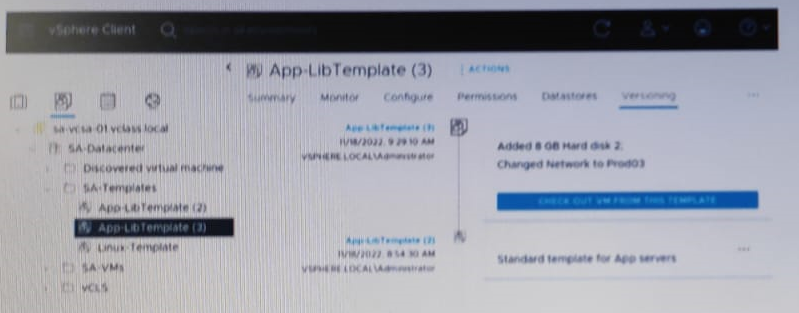VMware vSphere 8.x Professional 2V0-21.23 Exam Practice Test
An administrator is investigating reports of users experiencing difficulties logging into a VMware vCenter instance using LDAP accounts.
Which service should the administrator check as part of troubleshooting?
Answer : C
Identity Management Service is the service that handles authentication requests from LDAP accounts and other identity sources in vCenter Server.
When configuring vCenter High Availability (HA), which two statements are true regarding the active, passive, and witness nodes? (Choose two.)
Answer : A, D
When configuring vCenter High Availability (HA), two of the requirements for the active, passive, and witness nodes are that network latency must be less than 10 milliseconds, which ensures reliable communication between them; and they must have a minimum of a 1 Gbps network adapter, which provides sufficient bandwidth for data replication.
After a recent unexplained peak in virtual machine (VM) CPU usage, an administrator is asked to monitor the VM performance for a recurrence of the issue.
Which two tools can the administrator use? (Choose two.)
Answer : C, E
To monitor the VM performance for a recurrence of the issue, the administrator can use vSphere Performance Charts, which provide graphical views of various performance metrics for VMs and other objects; or ESXi Shell, which provides command-line access to ESXi hosts and allows running various commands to collect performance data.
An administrator Is performing maintenance activities and discovers that a Virtual Machine File System (VMFS) datastore has a lot more used capacity than expected. The datastore contains 10 virtual machines (VMs) and, when the administrator reviews the contents of the associated datastore, discovers that five- virtual machines have a snapshot file (-delta.vmdk flies) that has not been modified In over 12 months. The administrator chei kfl the Snapshot Manager within the vSphere Client and confirms that there are no snapshots visible.
Which task should the administrator complete on the virtual machines to free up datastore space?
Answer : A
Consolidating snapshots for each VM will merge any snapshot files that are not associated with a snapshot in Snapshot Manager into the base disk file and free up datastore space.
The presence of redundant delta disks can adversely affect the virtual machine performance. You can combine such disks without violating a data dependency. After consolidation, redundant disks are removed, which improves the virtual machine performance and saves storage space.
After a number of outages within a production VMware software-defined data center, an administrator is tasked with identifying a solution to meet the following requirements:
* Reduce the risk of outages by proactively identifying issues with the environment and resolving them.
* Reduce the complexity of uploading log bundles when raising support tickets.
Which solution should the administrator recommend to meet these requirements?
Answer : B
Skyline Advisor Pro is a self-service web application that enables you to receive proactive intelligence with new insights, accelerated analysis, and simplified design, within a web browser. To activate Skyline Advisor Pro, upgrade your Skyline Collector to Skyline Collector 3.0 or later versions.
The solution that should be recommended to reduce the risk of outages by proactively identifying and resolving issues with the environment and reducing the complexity of uploading log bundles is VMware Skyline Health, which provides automated support and proactive recommendations for vSphere.
An administrator decides to restore VMware vCenter from a file-based backup following a failed upgrade. Which interface should the administrator use to complete the restore?
Answer : D
Refer to the exhibit.

Given the configuration shown in the exhibit, what must the administrator do to delete only the latest version of the template?